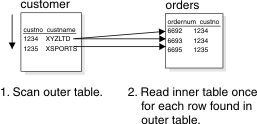Nested-loop join
In a nested-loop join, the database server scans the first, or outer table, and then joins each of the rows that pass table filters to the rows found in the second, or inner table.
SELECT * FROM customer, orders
WHERE customer.customer_num=orders.customer_num
AND order_date>"01/01/2007";The database server accesses an outer table by an index or by a table scan. The database server applies any table filters first. For each row that satisfies the filters on the outer table, the database server reads the inner table to find a match.
The database server reads the inner table once for every row in the outer table that fulfills the table filters. Because of the potentially large number of times that the inner table can be read, the database server usually accesses the inner table by an index.

If the inner table does not have an index, the database server might construct an autoindex at the time of query execution. The optimizer might determine that the cost to construct an autoindex at the time of query execution is less than the cost to scan the inner table for each qualifying row in the outer table.
If the optimizer changes a subquery to a nested-loop join, it might use a variation of the nested-loop join, called a semi join. In a semi join, the database server reads the inner table only until it finds a match. In other words, for each row in the outer table, the inner table contributes at most one row. For more information on how the optimizer handles subqueries, see Query plans for subqueries.